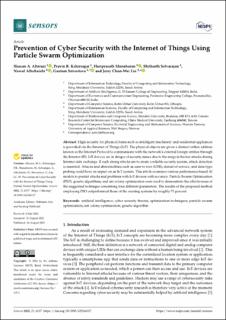| dc.contributor.author | Alterazi, Hassan A. | |
| dc.contributor.author | Kshirsagar, Pravin R. | |
| dc.contributor.author | Manoharan, Hariprasath | |
| dc.contributor.author | Selvarajan, Shitharth | |
| dc.contributor.author | Alhebaishi, Nawaf | |
| dc.contributor.author | Srivastava, Gautam | |
| dc.contributor.author | Lin, Jerry Chun-Wei | |
| dc.date.accessioned | 2023-03-23T09:35:48Z | |
| dc.date.available | 2023-03-23T09:35:48Z | |
| dc.date.created | 2022-09-14T11:22:16Z | |
| dc.date.issued | 2022 | |
| dc.identifier.citation | Sensors. 2022, 22 (16), . | en_US |
| dc.identifier.issn | 1424-8220 | |
| dc.identifier.uri | https://hdl.handle.net/11250/3060060 | |
| dc.description.abstract | High security for physical items such as intelligent machinery and residential appliances is provided via the Internet of Things (IoT). The physical objects are given a distinct online address known as the Internet Protocol to communicate with the network’s external foreign entities through the Internet (IP). IoT devices are in danger of security issues due to the surge in hacker attacks during Internet data exchange. If such strong attacks are to create a reliable security system, attack detection is essential. Attacks and abnormalities such as user-to-root (U2R), denial-of-service, and data-type probing could have an impact on an IoT system. This article examines various performance-based AI models to predict attacks and problems with IoT devices with accuracy. Particle Swarm Optimization (PSO), genetic algorithms, and ant colony optimization were used to demonstrate the effectiveness of the suggested technique concerning four different parameters. The results of the proposed method employing PSO outperformed those of the existing systems by roughly 73 percent.
Keywords: artificial intelligence; cyber security threats; optimization techniques; particle swarm optimization; ant colony optimization; genetic algorithm | en_US |
| dc.language.iso | eng | en_US |
| dc.publisher | MDPI | en_US |
| dc.rights | Navngivelse 4.0 Internasjonal | * |
| dc.rights.uri | http://creativecommons.org/licenses/by/4.0/deed.no | * |
| dc.title | Prevention of Cyber Security with the Internet of Things Using Particle Swarm Optimization | en_US |
| dc.type | Peer reviewed | en_US |
| dc.type | Journal article | en_US |
| dc.description.version | publishedVersion | en_US |
| dc.rights.holder | © 2022 by the authors | en_US |
| dc.source.pagenumber | 0 | en_US |
| dc.source.volume | 22 | en_US |
| dc.source.journal | Sensors | en_US |
| dc.source.issue | 16 | en_US |
| dc.identifier.doi | 10.3390/s22166117 | |
| dc.identifier.cristin | 2051572 | |
| dc.source.articlenumber | 6117 | en_US |
| cristin.ispublished | true | |
| cristin.fulltext | original | |
| cristin.qualitycode | 1 | |

